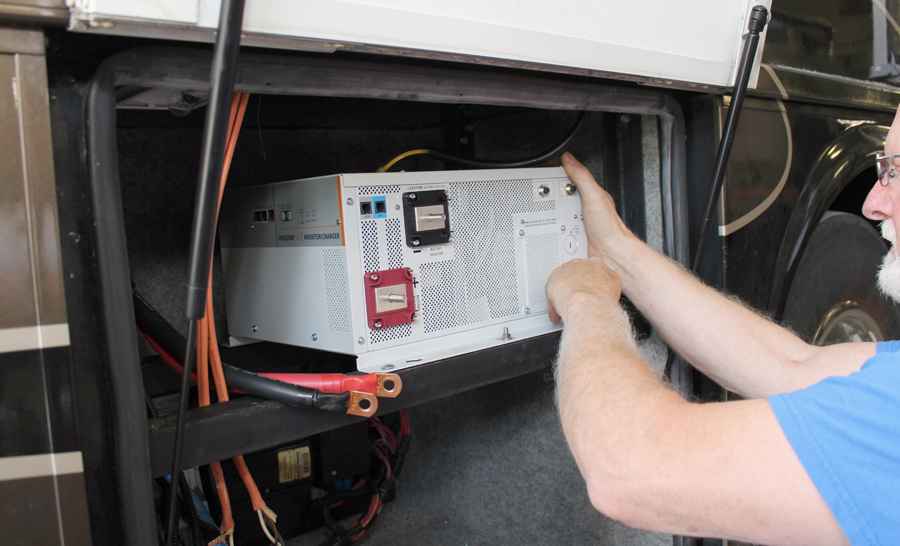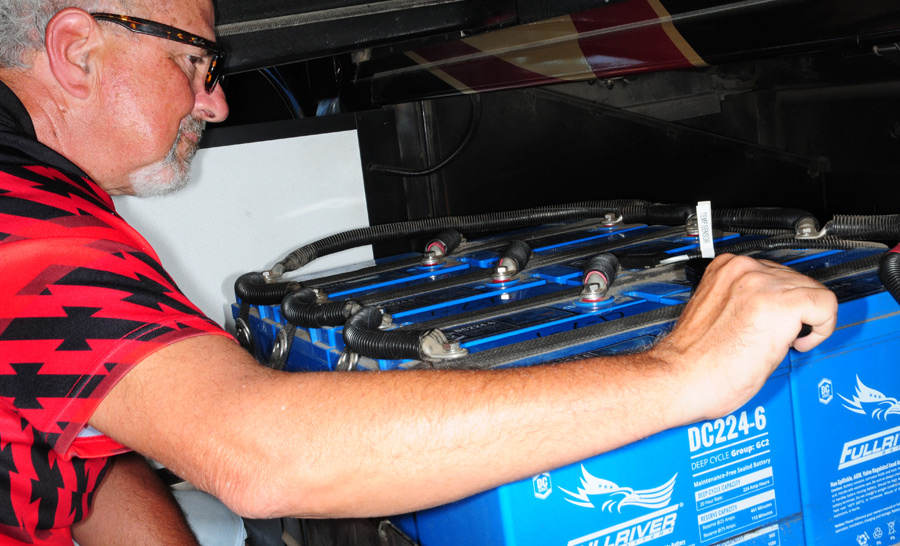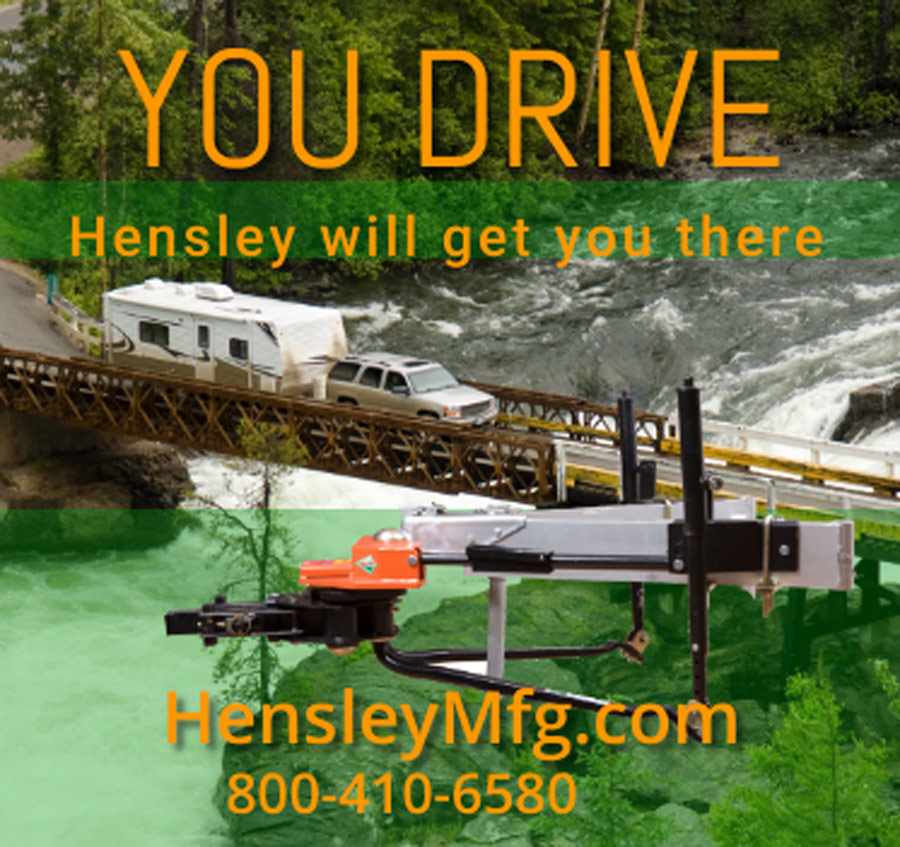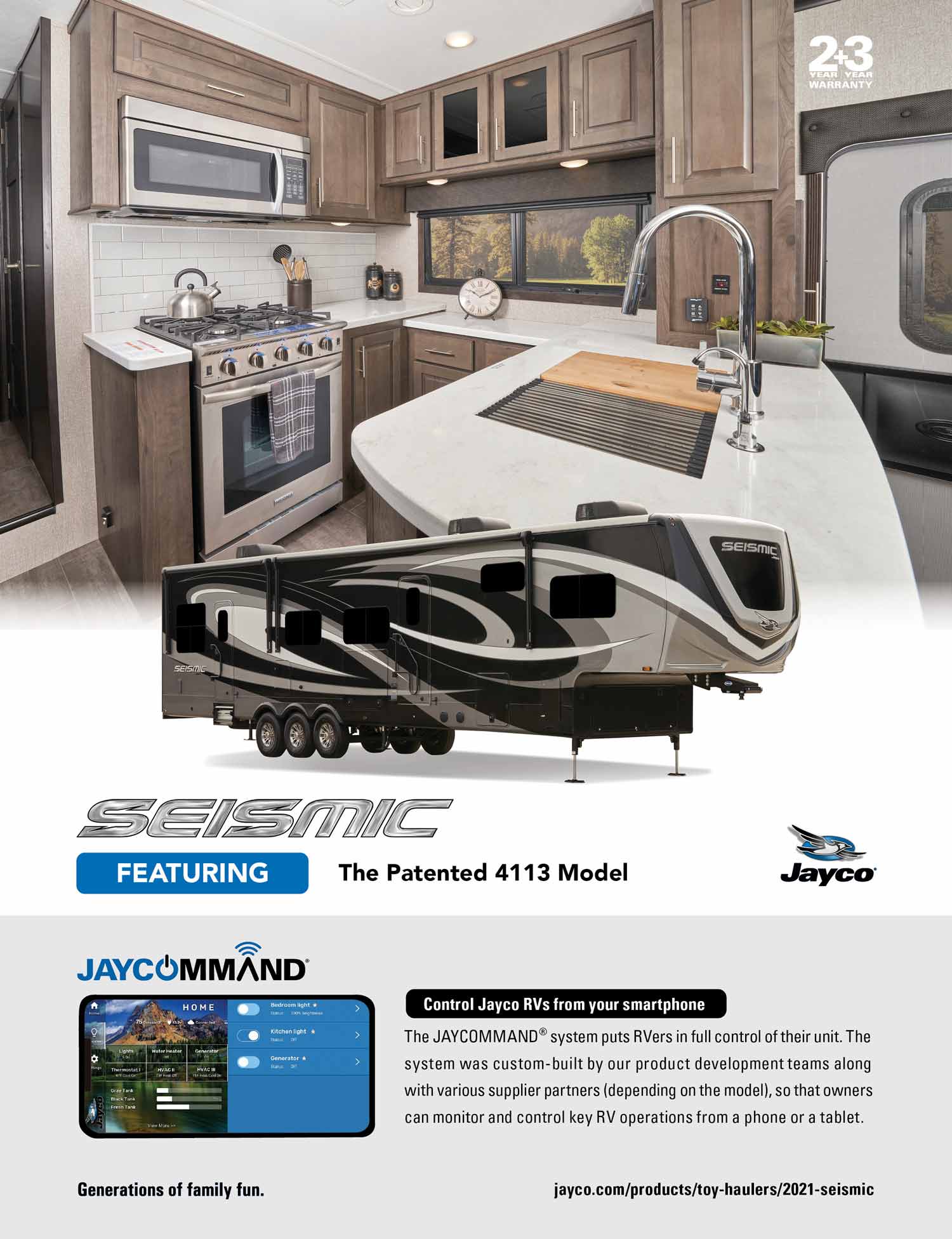Subscriber Access Only
Special Offer
Get 1 year of RV Enthusiast Magazine for just $9.99
Unlock My Offer No ThanksAlready a subscriber? Click here to access full issues.

Water has always been the nemesis of RVs due to their wood construction. Manufacturers are turning to composites to eliminate wood and its potential problems.
Annual furnace maintenance and cleaning are often overlooked — with predictable results. An annual inspection will help keep it in tip-top shape.
Replacing and updating a skylight can really improve and help illuminate your RV’s interior — while protecting its exterior.
RV water heaters tend to be taken for granted. By performing basic maintenance before and after each travel season, you can ensure it will work when you need it to.
A certain amount of stray voltage on the exterior of an RV is normal. Excessive voltage, on the other hand, is potentially life-threatening.
Sometimes the best travel stories aren’t about the destination, but the trip to get there — warts and all.

An inverter makes it possible to use household appliances in an RV — without a generator. We explain how they work and even show how to install one.
A step-by-step installation of a Bluetooth-monitored 320-watt solar array on a towable camper/garage.
Comparing lead-acid, AGM and lithium batteries by weight, energy capacity, maintenance, mounting considerations, longevity — and cost.
Not all drinking water is the same — but installing water filtration and purification units will improve water quality and protect your health.
A look at some of the latest off-grid RVs. For anyone seeking the path less traveled, the choices have never been better.
(800) 830-9729 ext. 3
[email protected]
EDITOR – Bruce Hampson
(574) 584-4616
[email protected]
TECHNICAL DIRECTOR
Chris Dougherty
(800) 830-9729 ext. 5
[email protected]
TECHNICAL EDITOR – Chris Hemer
(800) 830-9729 ext. 6
[email protected]
SOCIAL MEDIA DIRECTOR – Jim Mac
(800) 830-9729 ext. 7
[email protected]
ART DIRECTOR – MIKE ACCUARDI
[email protected]
120 Atwater Road, Springfield, MA 01107
RV Enthusiast is published monthly by RVE Media Group Inc., 3425 East Golden Valley Road, Reno, NV 89506. RV Enthusiast magazine is copyrighted in the United States, Canada, Great Britain and other countries. All rights reserved. Permission to reprint or quote excerpts considered on an individual basis and granted only by written request. Advertising rates and Editorial calendars provided upon request.









’ve been around recreational vehicles for much of my life, starting with a truck camper my father acquired when I was just a wee lad and was used to transport our family — including my mom and two brothers — across country for bi-annual visits to our East Coast-based brethren.
The memories of those trips are cherished, as are recollections of one amazing summer I spent cruising across the country behind the wheel of a partially restored/modified ’78 Winnebago Brave with my then-6-year-old son, Jeremy, and our Siberian Husky. I’m sure more than a few of my friends’ neighbors didn’t care for that big “eyebrow” Winnebago parked streetside for a week or two at a time as we visited, but local regulations were a lot more lenient at the time.
Just as entertaining, though, are the recollections of “us boys” keeping ourselves occupied when my dad wrenched on his pickup truck at various times during our trips. Ditto my escapades in that old Winnebago, including the time I was forced to search for a couple of aluminum soda cans, cut them open and, using worm hose clamps, cinch them around a broken header pipe on the RV’s big V8 until I could find a decent welding shop to close the hole. Yea, I’m a baling-wire kind of guy.

When Forest River Inc. introduced its No Boundaries travel trailer lineup in late 2017, the rugged towable line helped push the envelope in lightweight, versatile trailers that could be towed by the type of smaller vehicles often used to head off-highway. The modified teardrops have proven popular with outdoors enthusiasts by offering such features as a mix-and-match Rhino Rack system for carrying everything from jerry cans on the side to kayaks on the roof.
Built with a 12-volt DC power system and solar prep, the line comes in both “traditional” travel trailers as well as off-road editions.
Small wonder that Rollin’ On TV, the nation’s premier weekly RV-oriented show, partnered with Forest River in 2020 to offer a specially outfitted “NoBo” travel trailer as the grand prize in a raffle designed to benefit KOA Care Camps. The camps host children with cancer to a fee-free week of camping at various locations throughout the year. Since inception, Care Camps has raised more than $16 million so kids can attend camp.

othing is more stressful than worrying about your pet left alone inside an RV. Will your furry traveling buddy tear the place apart, or suffer from crippling heat because of an HVAC issue? Will your dog bark incessantly? Modern technology has made it easier to keep tabs on our pets remotely via a smartphone, and even talk to them to control bad behavior or just to say “hello.” I’ve enlisted two simple-to-use devices that have become indispensable in our fulltime RV household.
The Eyes Have It
Technology has made it possible to “spy” on our pets at a low cost. After studying the field of remote cameras and first settling on a model that just didn’t work, I found the Kamtron 1080P WiFi Pet Camera on Amazon. It has all the features needed to keep an eye on our standard poodle and at around $40, the investment was rather low for a camera packed with features. There are dozens of these cameras on the market, so doing a little homework is paramount.
ost RVers love food. I know we do. We love talking about food, love discovering new flavors, love new recipes and sharing old ones. Like many other RVers, we also love to entertain and often have spontaneous small gatherings. And, after teaching for a combined 50+ years (yikes) we learned several important lessons: Always be overly prepared for everything, bring your own food, pack more food than clothes and definitely have more than one corkscrew handy.
So what is the Culinary Camper? It’s all about how to prepare favorite foods and the occasions when they are shared. Simple ingredients, when well prepared, can turn any day into a memorable experience on the road.
Of course, one of the challenges we all face in our RV kitchens is lack of space and the need to not add unnecessary weight. That’s okay. One thing we’ve noticed about RVers is that they are often “gadgeteers” and accomplished DIYers — planning, packing, and provisioning all the essentials (and then some) required for living in their rolling homes.

hese tasty and fortifying make-ahead sandwiches are robust, flavorful and part of our families’ travel menu. You can make them for picnics, as a late-night, no-fuss dinner and for informal entertaining, too. This hearty sandwich travels very well when wrapped tightly and is stowed in a handy cooler. Riding down the highway will only enhance the flavors; you’ll soon add this to your sandwich repertoire. You’ll need about 15 minutes for some prep-work before assembling your sandwiches.
t’s safe to assume that the words “pick-up truck” and “serenity” have rarely been used in the same sentence. After all, trucks were engineered with specific uses in mind — pulling heavy trailers, hauling big payloads and trundling down rutted roads en route to the farm or worksite.
So you can imagine my surprise when I pushed the start button in our test 2021 Ford F-150 PowerBoost hybrid and experienced…nothing.
In a Toyota Prius, for example, the initial absence of an internal combustion engine wouldn’t come as any surprise. But in a truck capable of towing up to 12,700 pounds, it felt surreal. A message on the digital instrument cluster told me the truck was ready to drive, so I eased the Antimatter Blue-toned SuperCrew out of the parking lot. It was more than a quarter mile down the street before its 3.5-liter EcoBoost engine finally came to life. When it did, it was with little fanfare — just a subtle purr, like the dutiful hum of a well-worn sewing machine. There are luxury cars that aren’t this quiet.
hat if you want the benefits of on-board 120-volt AC power in your existing truck or tow vehicle but can’t spring for the cost of the new F-150 PowerBoost? Mobile Electronic Power Solutions (MEPS) of Garland, Texas offers a wide range of products to help you power up household appliances (or tools) when RVing off the grid using engine power as the source. The main component of the company’s basic system is a generator (resembling a large alternator) that is mounted to the engine via an application-specific bracket. The generator converts rotating mechanical power from the engine into variable electrical power via the alternating current unit (ACU). The ACU controls the generator and converts its power into clean sinewave power. The basic 3kW system includes the generator, pulley, engine bracket, ACU and cabling and retails for $5430, plus 6 to 12 hours of installation time. It’s not cheap, but when completed, you’ll have a rugged system that has been proven reliable in fire and rescue/EMS, government/military and commercial vehicle applications.


ater has been the nemesis of recreational vehicles almost from the moment the first RVs were produced more than 100 years ago. Actually, the problem isn’t water by and of itself, but the fact that the average RV today has dozens of openings cut into its outer skin. Some are as small as screw holes to cinch down rooftop vents, satellite TV antennas and the like, while others are major cutouts for doors and windows — and every one of them presents a possible incursion site for water to leak into the RV if they aren’t properly maintained and repaired.
Of course, once water does manage to find its way inside, bad things tend to happen. Most RVs continue to be built with wood internals, from framing to floors — and wood has a tendency to attract water like a magnet attracts iron filings. Over the long term, this creates wood rot as fungi attack the wood and cause the fibers to degrade. Most wood craftsmen will tell you that four conditions need to be present for this to occur: wood, oxygen, warmth and, of course, moisture. Obviously, all exist in a typical RV environment. It’s a simple problem with complex solutions, because while you can reseal incursion points, once the water is inside the only real recourse is to replace the substrate.


Photos by the author
ost motorhomes, trailers and truck campers have some form of comfort heating to maintain interior warmth during cold days and nights. The vast majority of RVs use a forced-air furnace complete with a network of ducting that runs through the floor or cabinetry, terminating with registers to distribute warm air.
Unfortunately, annual furnace maintenance and cleaning are often overlooked, which can lead to poor performance, malfunction and even failure. And — you guessed it — problems seem to only crop up when you need heat the most. Annual cleaning is important because the return air system does not include a replaceable filter to prevent dust, lint and pet hair from impacting performance and safety. Following these preventive maintenance procedures will give your heating system the advantage during the cold weather.

Photos by the author

f you’re like many RVers, walking into a dim, dank RV with a dirty, faded and scratched skylight is downright depressing. From a practical standpoint, unmaintained skylights are a leading cause of water damage. Aesthetically, things aren’t much better; the amount of light an ignored or overlooked skylight allows inside does little to enhance the joy of RV ownership.
So, what goes wrong with RV skylights, and why should we replace them? Quality RV skylights are generally made of an impact-resistant polycarbonate plastic that can remain in service for years. But as time goes on, they can become scratched and faded — and many crack as a result of UV exposure. The more brittle they get, the easier they can break from hail or branch hits. Of course, once they crack, they leak. A skylight dome that has a crack is already brittle, so while repairing it with a waterproof tape like EternaBond may work temporarily (and it won’t be pretty), the rest of the dome is likely to fail quickly.


t’s hard to imagine life on the road without a water heater. From washing hands to bathing and doing dishes, it is one of the key appliances that makes life in an RV comfortable.
RV tank storage hot water systems are not complicated devices, and in fact are much like the units found in most residences, albeit smaller. The fact that they have not changed much through the years is testament to their reliability; the bulk of RVs on the market today still use 6- or 10-gallon units manufactured by either Atwood or Suburban, and they can last for years if they’re properly maintained. However, if they’re stored for months outside without being maintained or were not properly drained before the end of the season, you could be repaid this spring by a water heater that won’t fire or produces water that smells like rotten eggs. The good news is, these problems are easy to repair yourself, even if you’re new to RVing.


 An inverter makes it possible to use household appliances in an RV–without a generator
An inverter makes it possible to use household appliances in an RV–without a generator 
ry to imagine if electricity were like cellular service, where some places you travel have it while others don’t.
That’s the gamble that all RVers take when they head out onto the open road with no agenda. You might find yourself at a cozy local RV park with full hookups. Then again, maybe you’ll stop for the night under the stars of a national park campsite accompanied by little more than the hum of an absorption refrigerator fan and a few 12-volt DC lights to remind you of civilization.
That’s not necessarily a bad thing — unless you’re really hungry and the only thing you have is a frozen dinner. You turn to find the microwave staring back at you with its sullen, tempered glass eye…mocking you. The TV, meanwhile, offers only a cold and expressionless field of empty space in exchange for your longing glance. Thank goodness for a dogeared copy of Huck Finn and an old bag of potato chips.

Photos by the author
 Boondocking on
Boondocking onBatteries
Photos by the author
ower inverters are available in a number of sizes — with correspondingly greater wattage output — to fit the requirements of just about any RV. Smaller, portable inverters with fewer features can be found for less than $400, while larger units usually require a permanent installation and can set you back as much as $2,000. Those prices, by the way, are only for the inverter. If you only need a portable unit, you can hook it up yourself. Permanent installations, on the other hand, usually require the expertise of a knowledgeable technician.
The owner of this fifth-wheel had a number of requirements for the unit’s inverter: pure sine output waveform technology, the ability to charge lithium iron phosphate batteries, maximum off-grid power output and the ability to charge onboard batteries when hooked into shore power or when using the AC generator. The inverter selected — the MagnaSine Hybrid 3,000 MSH3012M inverter/charger from Magnum Energy — provided yet another benefit: the ability to combine energy from both incoming AC power and batteries to power loads. (With most inverters, it’s an either/or proposition.)






enewable energy is a huge topic in the RV space, and for good reason. Not only are RVers, as a community, environmentally adept, but solar systems — especially when combined with the latest power inverter and battery technology — allow electrical independence for off-grid camping. Renewable energy systems in RVs are nothing new, but technology is advancing, prices are dropping and RVers’ interest in off-grid travel is off the charts.
That’s not surprising to anyone who has been RVing for any length of time. In fact, the popularity of harnessing “free” power — to say nothing of the various systems available — is such that you will see this technology covered in the pages of RV Enthusiast regularly as power from the sun, wind and other sources become more widely available.



o you really need a battery in your RV?
Let’s get this question out of the way first. If you’re plugged into shore power 100% of the time and only rarely move your RV, then there’s nothing forcing you to have a “house” battery at all. That’s because even though most of your RV’s electrical system (such as lighting, furnace control and monitoring systems) is likely powered by 12 volts DC, all modern RVs include something called a “converter.” This component’s job is to provide around 12 to 14 volts DC (direct current) at 40 to 60 amperes of current for general electrical needs.
Of course, this 12-volt DC power doesn’t include heavy appliances such as your convection microwave oven, rooftop air-conditioner or electric water heater, each of which require a dozen or more amps of current at 120 volts AC. But if you’re plugged into shore power (or a generator) the converter takes care of the 12-volt DC requirements of your RV while your power center distributes 30 or 50 amps (two 50-amp legs for 100 amps total) to all your 120-volt AC power hungry appliances. But that’s a different story altogether.


ow much do you know about the drinking water where you live? Odds are, you know enough to purchase bottled water, a filter pitcher, or some other solution to protect yourself and family from the nasties that can sometimes be present in a municipal water system. But what about when you travel by RV? Once you arrive at your destination, you may have no knowledge of the water quality in your area, where it comes from or how it has been treated. That’s probably fine for showers and washing dishes, but there’snary an RVer who will drink water right out of the tap — unless they treat it themselves before it enters through the city water inlet or before filling the storage tank.
While all water suppliers in the U.S. are required to uphold certain levels of water quality — which theoretically make tap water safe to drink — violations are still alarmingly common. According to a 2017 report by the Natural Resources Defense Council (NRDC), nearly 77 million Americans got water from systems that violated federal protections in 2015. More than a third of this number relied on systems that did not comply with standards put in place to protect public health. For RVers, these concerns may be compounded by a poorly maintained local water supply at an RV park or campground, and/or a spigot that may not be sanitary. With all this in mind, a system that both filters and purifies the water entering your RV would be a smart investment.

hose of you who are seasoned veterans of camping have likely encountered “hot skin” situations a few times over the years. New RV owners, however, may be surprised and alarmed the first time they touch the side of their RV while standing on the ground and feel a shock. Is this normal? Can it possibly be dangerous? No, it’s definitely not normal. And yes, it can be dangerous under certain conditions and circumstances. But first, let’s get a few definitions out of the way.
What is “Hot Skin”?
There’s really no formal definition of a hot-skin voltage in the National Electrical Code (NEC). In fact, the phrase “hot skin” is unique to the RV industry. In nearly all other industries and trades it is called a “contact voltage” or “stray voltage.” However, I’ll stick with the term “hot-skin” since that’s what the RV industry has been calling it as far back as the 1960s.

here was a time when being “down in the boondocks” carried a bit of a negative connotation. It was slang for an isolated, rural environment that was often difficult to access — the backwoods — and, sometimes, just as hard to get out of. It was a place where the trappings of civilization usually ended and you were on your own.
Today, “boondocking” — RV-speak for camping off-grid — is perhaps the fastest-growing segment of the RV lifestyle as Millennials and Gen-Zers, the biggest group of new RVers through the past five years, look beyond campgrounds and RV resorts for “experiential” outdoor adventures.
Not surprisingly, the RV industry has embraced these younger buyers by tooling up to design and manufacture everything from single-axle “adventure” trailers to fully outfitted truck campers and Class B motorhomes designed to function for days — and sometimes weeks — without hooking up to sewer or electrical connections. Indeed, even fully electrified higher-end fifth-wheels are now offered with enough solar panels and batteries to meet camper demands when heading off into the outback.


Bolt Lock and Strattec Security Corp., (844) 972-7547, boltlock.com

Dicor Products, (800) 837-2059, dicorproducts.com

oondocking is gaining in popularity every day, and there’s a little-known camping spot on Antelope Island in Utah that is a must see. This island is one of 17 on the Great Salt Lake, ranging from small to large, in all corners of the lake. In fact, the number of islands actually varies, depending on the elevation of the lake’s surface. This area is a closed basin, which means there is no drainage outlet for the lake — yet water depth can vary as much as two feet a year. Because of this great range of water levels between years, what may be considered an island in a high-water year may be considered a peninsula in another, or an island that appears in a low-water year may be not be visible in a high-water year. Antelope Island is the largest island in the Great Salt Lake and the only island with reservable primitive campsites.
The history of Antelope Island is quite interesting, and signs of early inhabitants can still be seen on the island today. Thousands of years ago, the area’s native Ute people inhabited Antelope Island, later followed by settlers from the Mormon Church. Fielding Garr established a ranch on the island in the late 1840s and brought the Mormon church’s cattle to the ranch. The ranch later bred horses and became a sheep ranch. Several original buildings of the Fielding Garr Ranch still stand on the island, and visitors can take a self-guided tour of the ranch during daylight hours. There is no charge to tour the ranch, though a donation is requested for the tour guide booklet. It is well worth the stop, and it will take approximately 90 minutes to tour the buildings and the ranch.














































